A 75-year-old man from Kerala who recently travelled to Vietnam and Cambodia was on Friday (October 11) diagnosed with the bacterial disease murine typhus.
After completing his trip, the patient sought medical attention on September 8, complaining of body pain and fatigue. Tests for rat-induced and flea-borne diseases were inconclusive, although it was found that his liver and kidney functions were deteriorating.

After considering his travel history, the doctors suspected his ailment to be a case of murine typhus. This marks the first case of the rare disease reported in the state.
Here is what to know about the disease, its spread, symptoms, treatment and prevention.
What is murine typhus?
Murine typhus is an infectious disease caused by the flea-borne bacteria Rickettsia typhi. It is transmitted to humans through the bites of infected fleas. The disease is also known as endemic typhus, flea-borne typhus or flea-borne spotted fever. Rodents like rats, mice and mongoose, are known to be reservoirs of the disease.
The disease-carrying fleas can also live on other small mammals, including pets such as cats and dogs. Once a flea is infected, it can spread the disease for the rest of its life.
How does murine typhus spread?
The disease is spread when infected flea faeces come into contact with cuts or scrapes in the skin. Transmission can also happen through exposure of mucous membranes to infected flea faeces. Murine typhus is not spread from one person to another, or from person to fleas.
Story continues below this ad
The disease has been reported in coastal tropical and subtropical regions, where rats are prevalent. In India, cases of murine typhus have been reported in the Northeast, Madhya Pradesh and Kashmir.
What are the symptoms of murine typhus?
The symptoms usually appear seven to 14 days after the exposure and include fever, headaches, body aches, joint pains, nausea, vomiting, and stomach aches. Some people may later develop rashes on the skin, days after the initial symptoms. The illness seldom lasts longer than two weeks, but may last for months with complications if not treated.
In the case of the Kerala patient, Next Generation Sequencing (NGS) technology, which uses microbial DNA, was used to identify the diagnosis. Further tests were conducted in CMC Vellore for confirmation.
What is the treatment for murine typhus?
There is no vaccine currently available against the disease. The antibiotic doxycycline is considered effective in therapy, but early diagnosis is vital for treatment. Without timely treatment, the disease could turn severe in one or two weeks, and become fatal in rare cases.
Story continues below this ad
How can one prevent themselves from murine typhus?
Households with pets should ensure that fleas are kept off them, through regular washing and awareness about the signs of fleas. A flea treatment should be done if needed.
Rodents should be kept away from households and kitchens in particular, with food items properly covered.








































